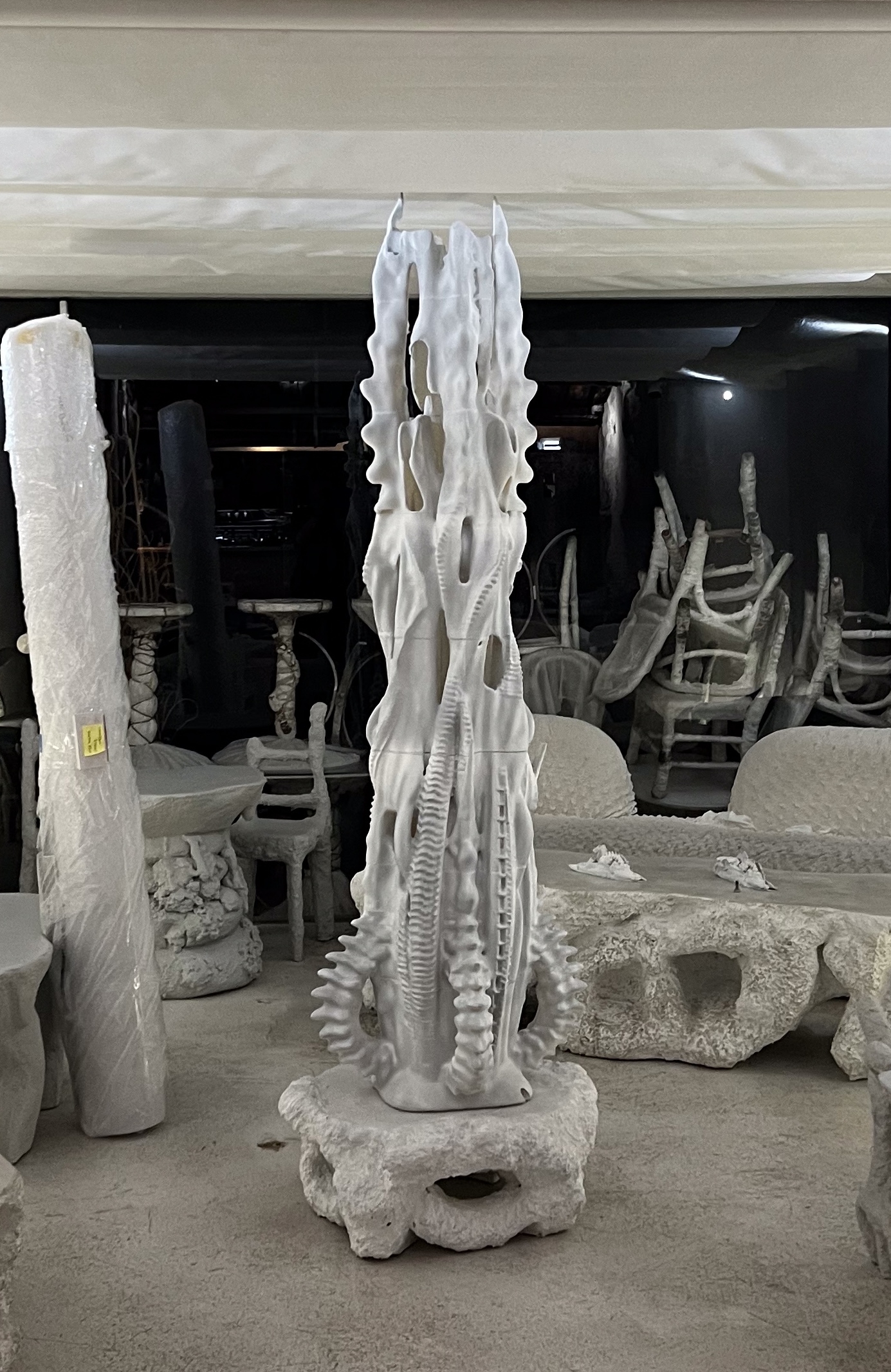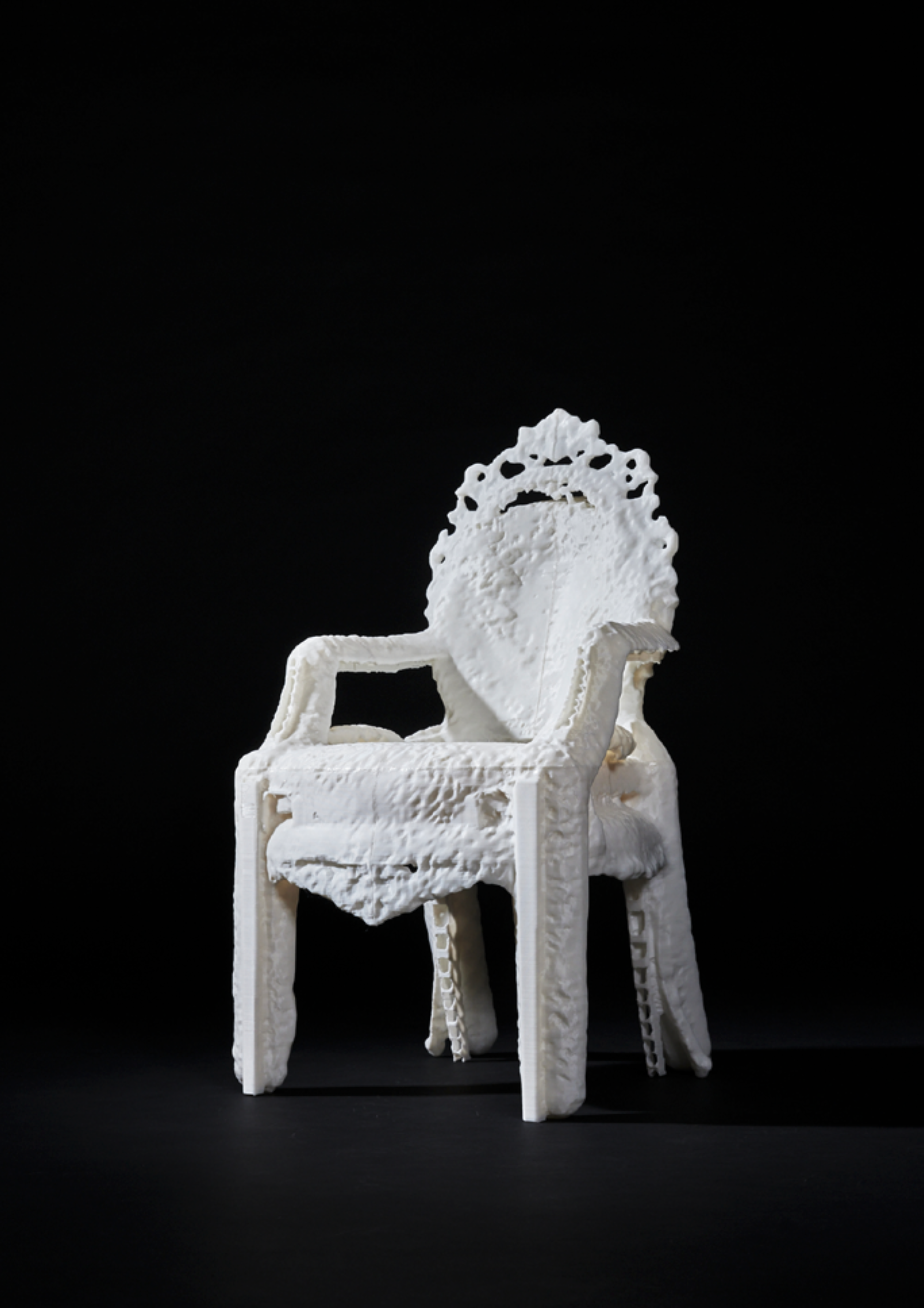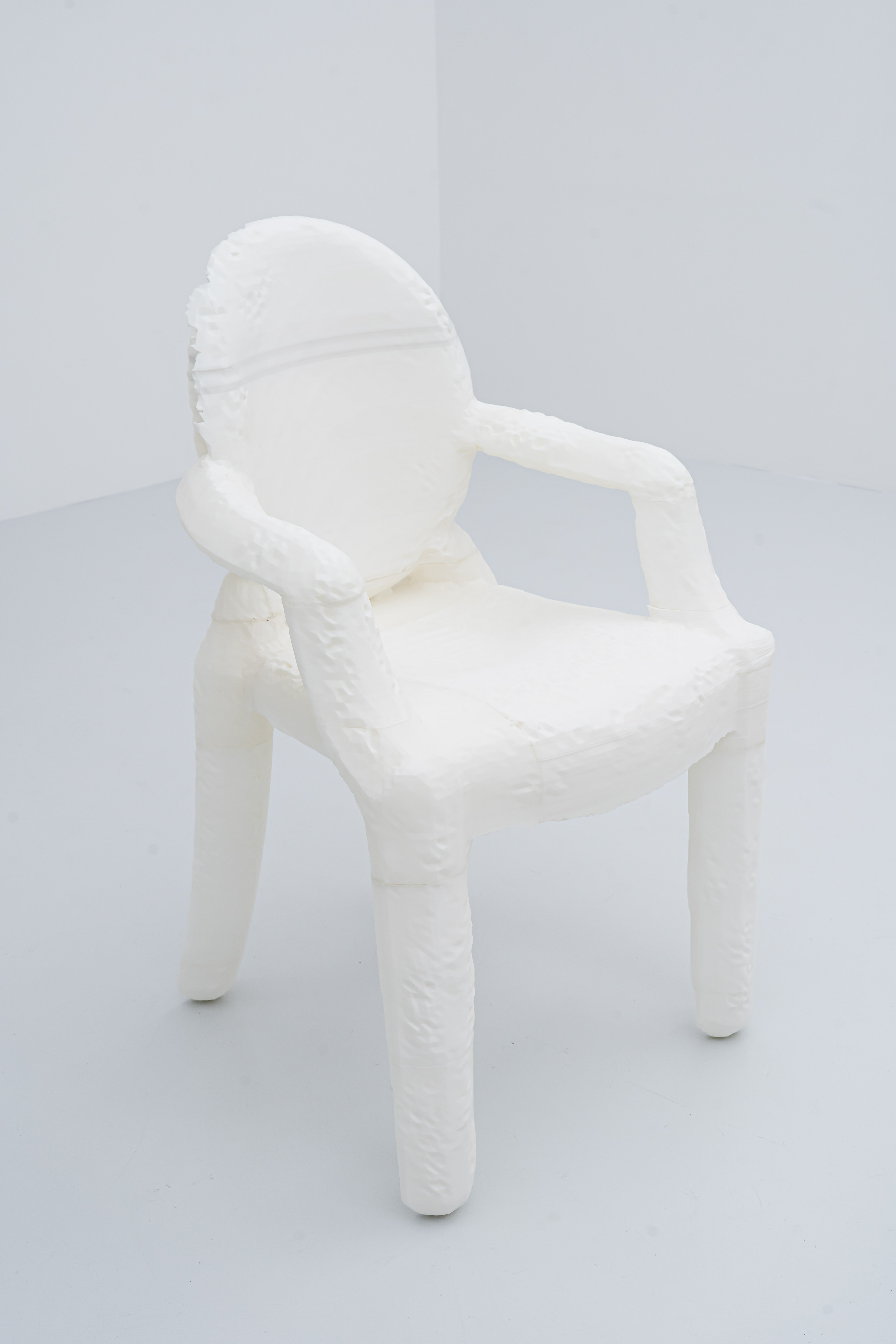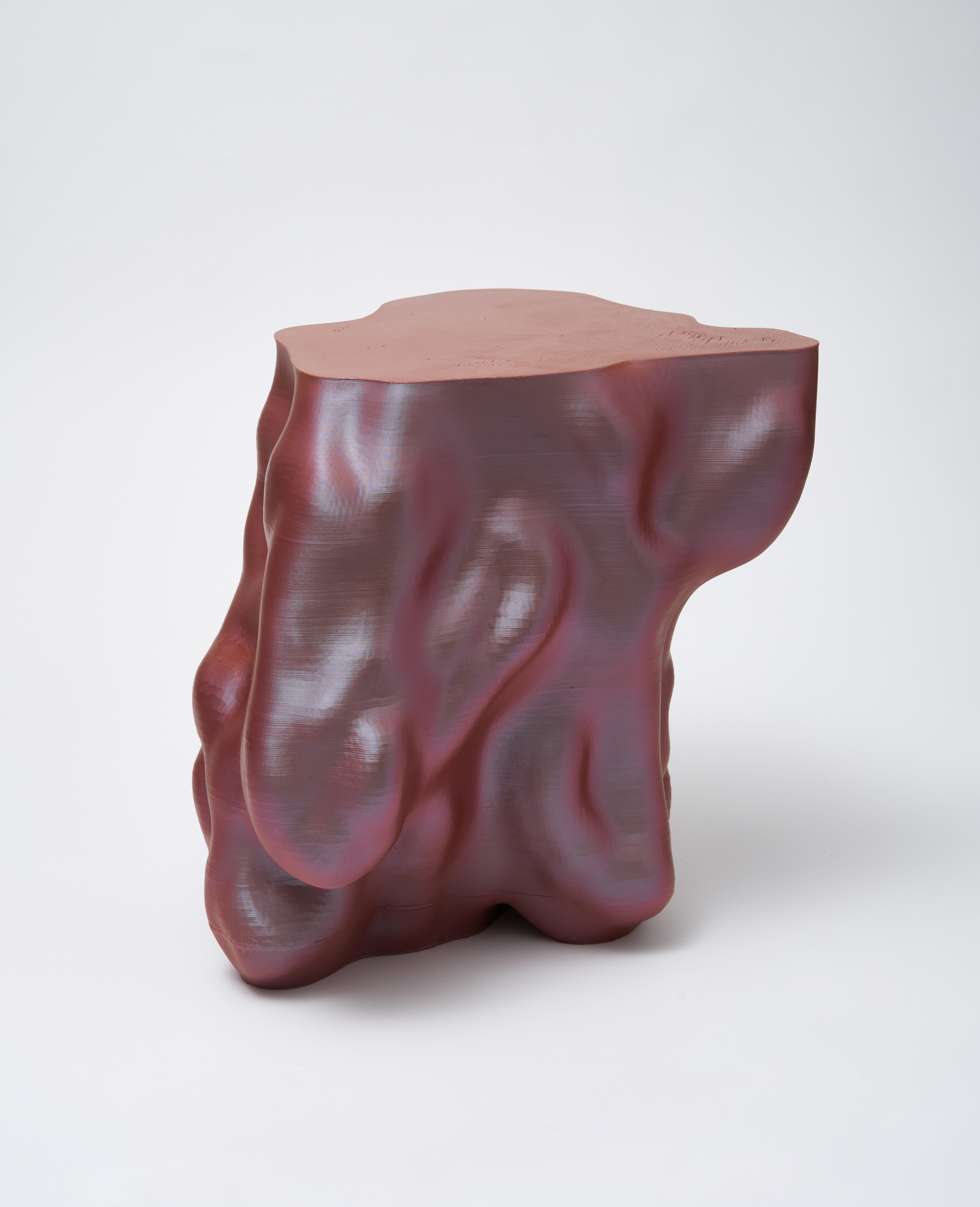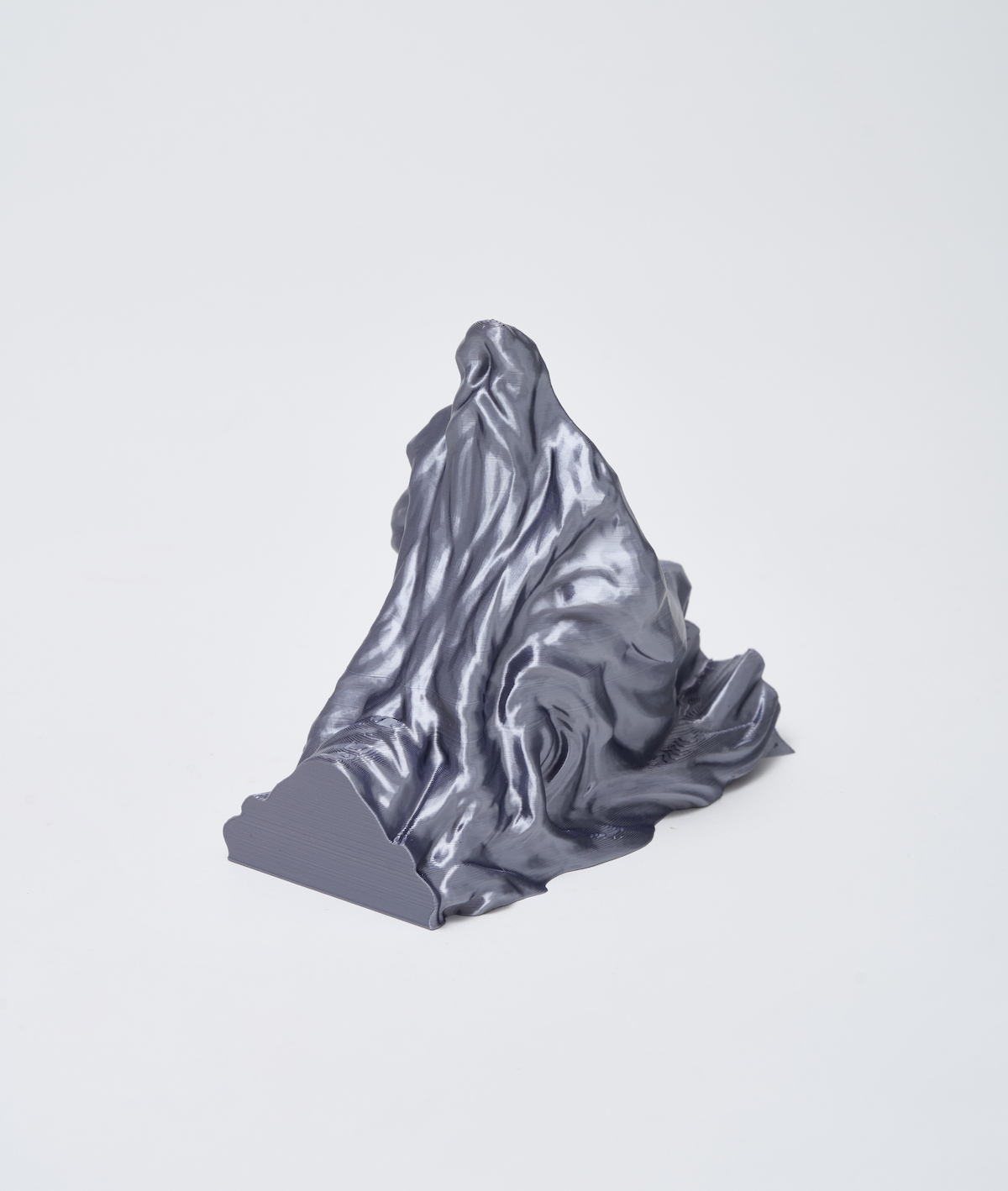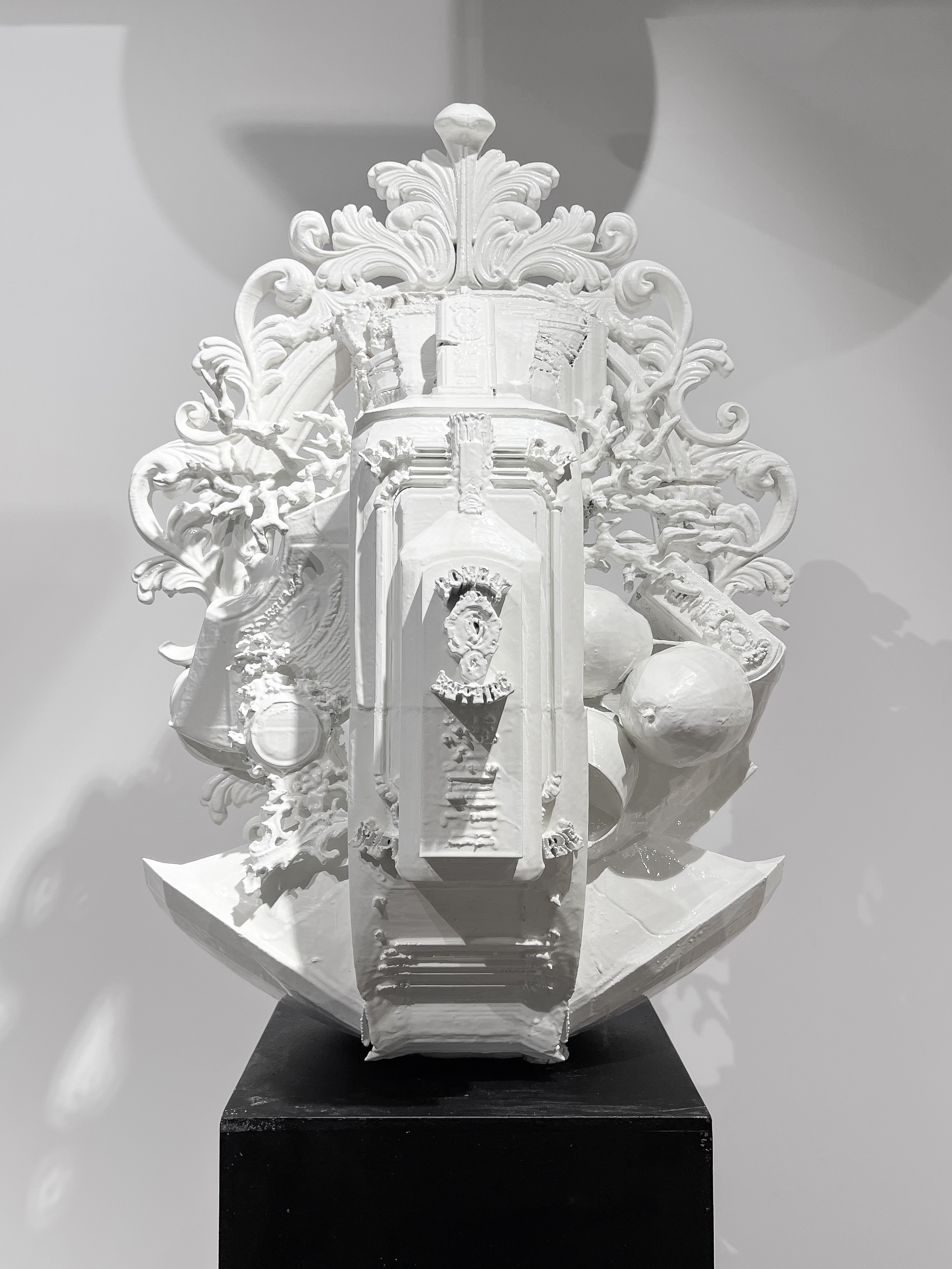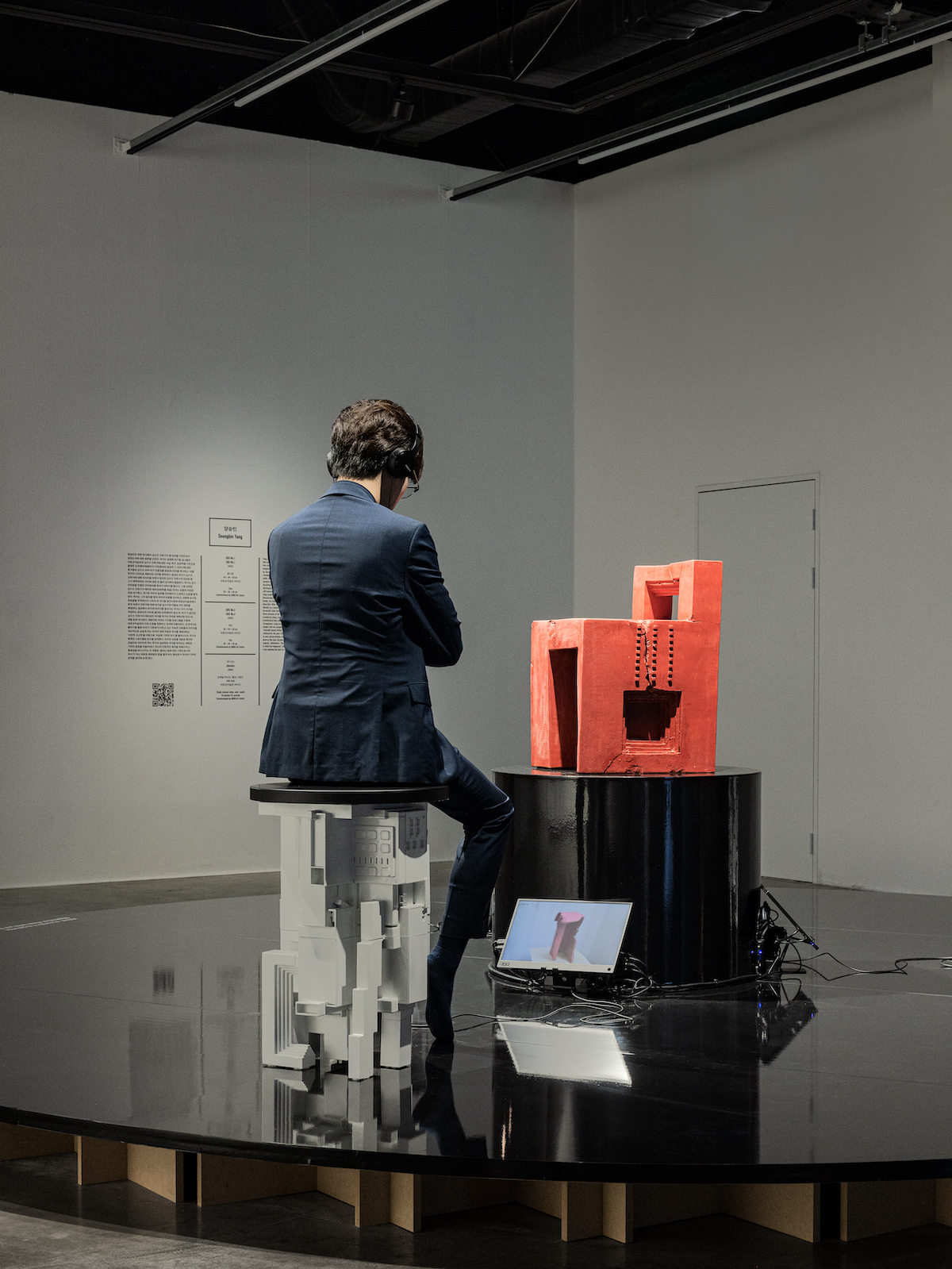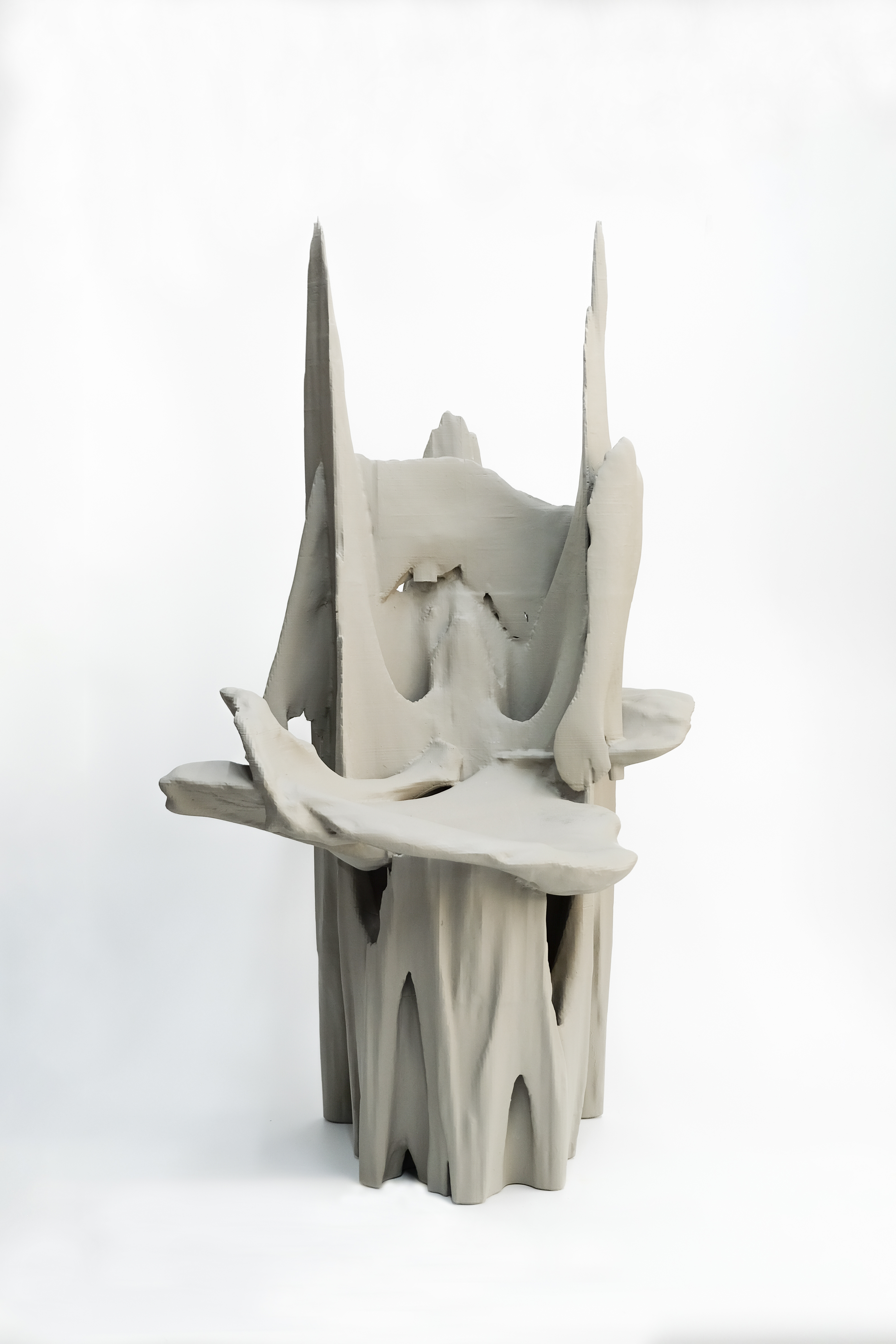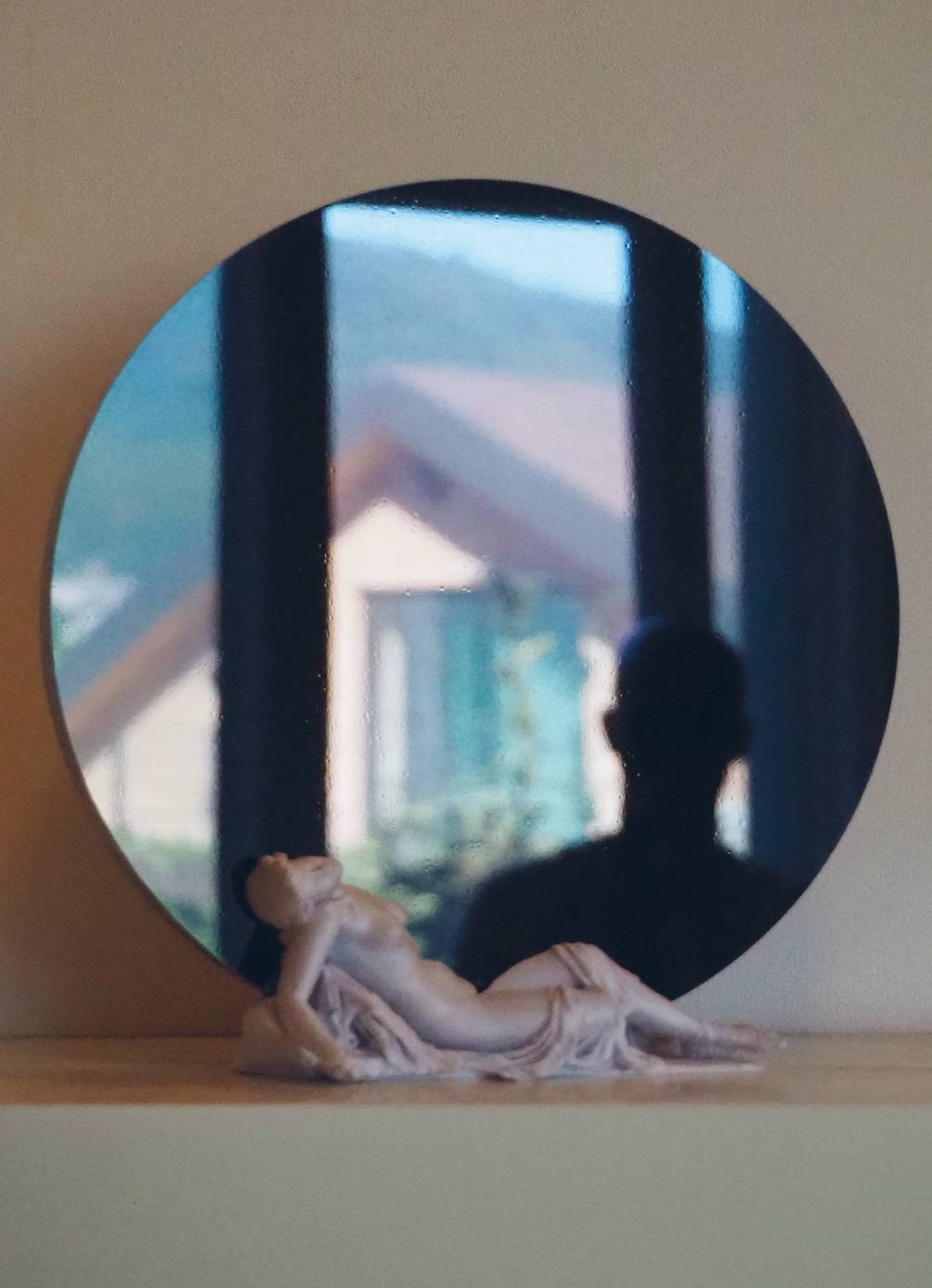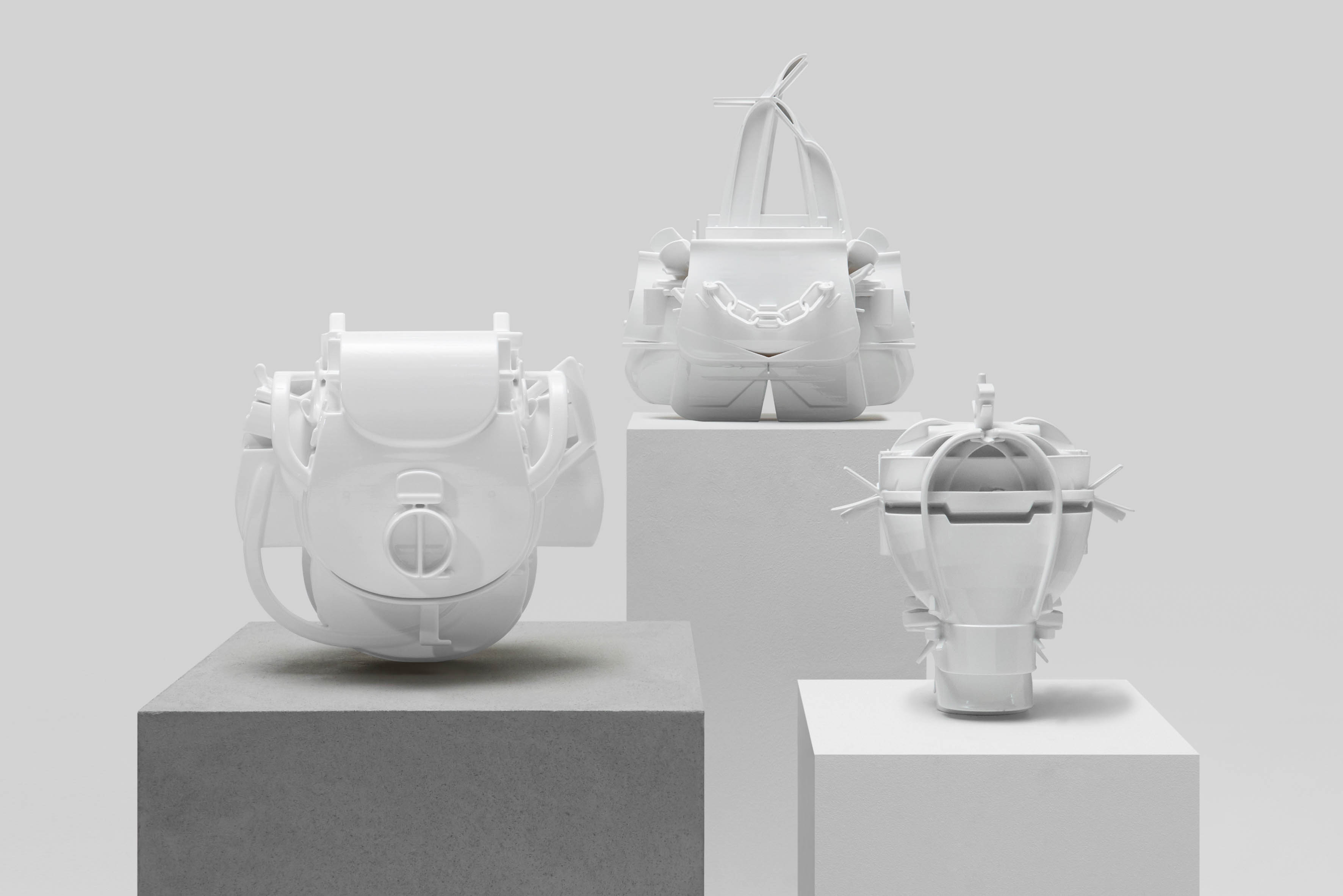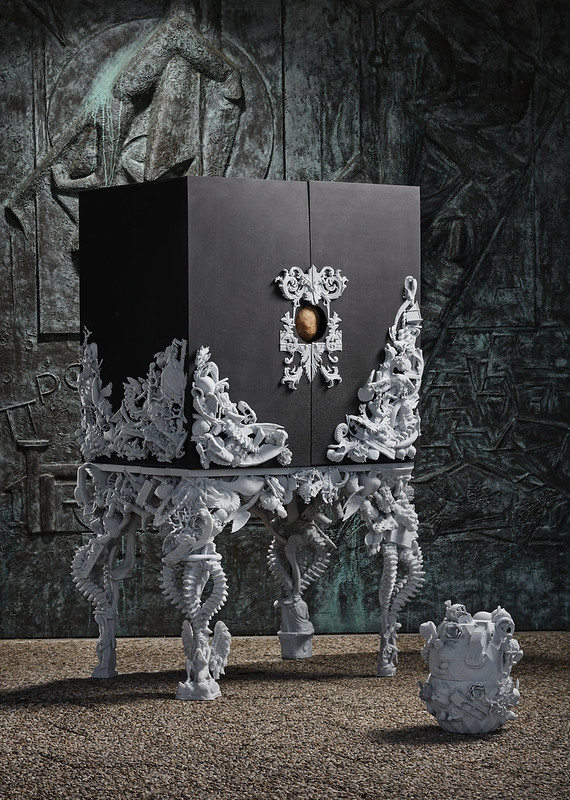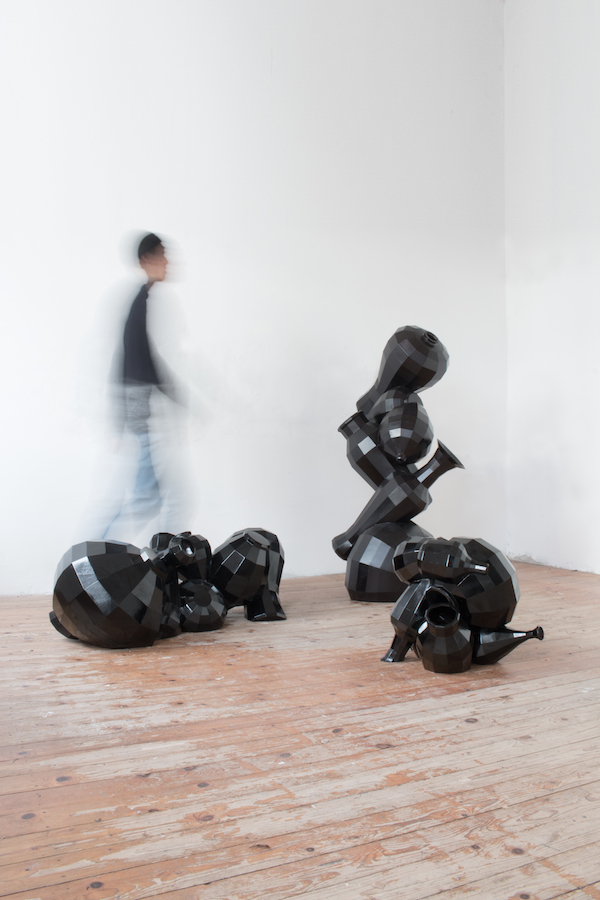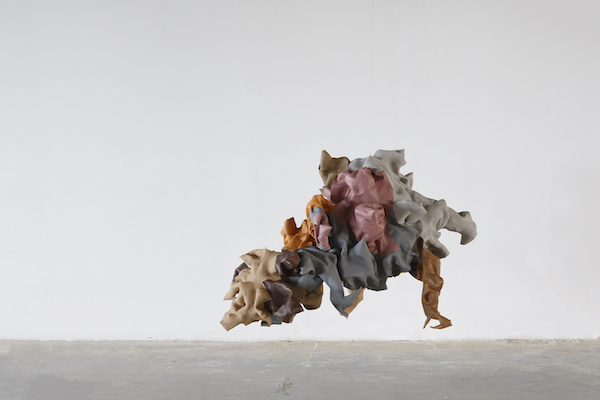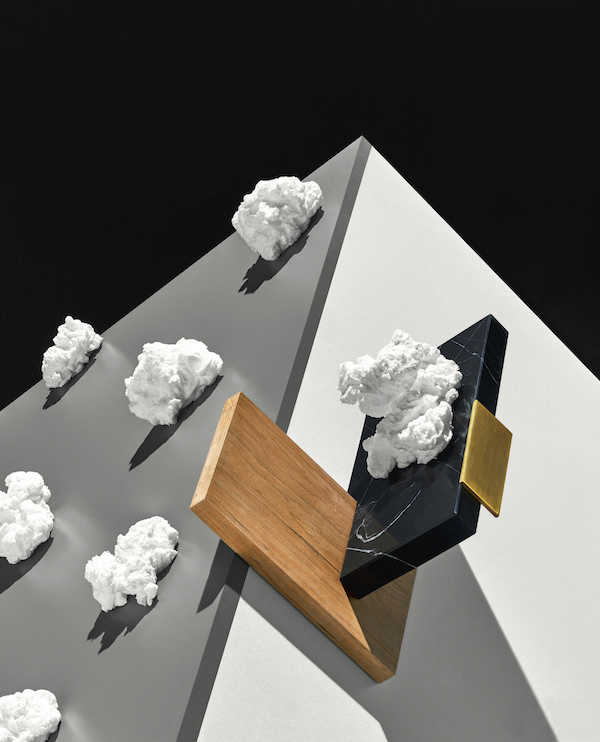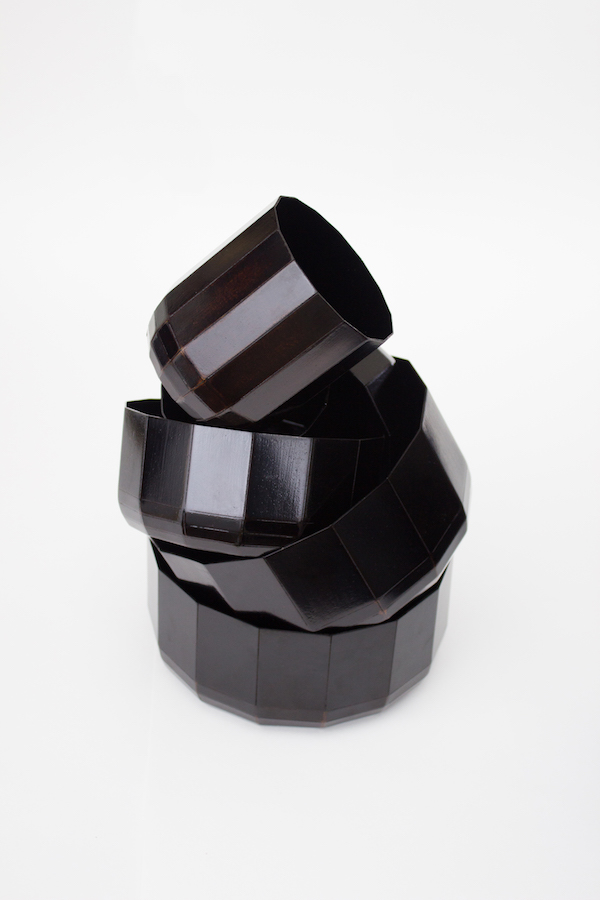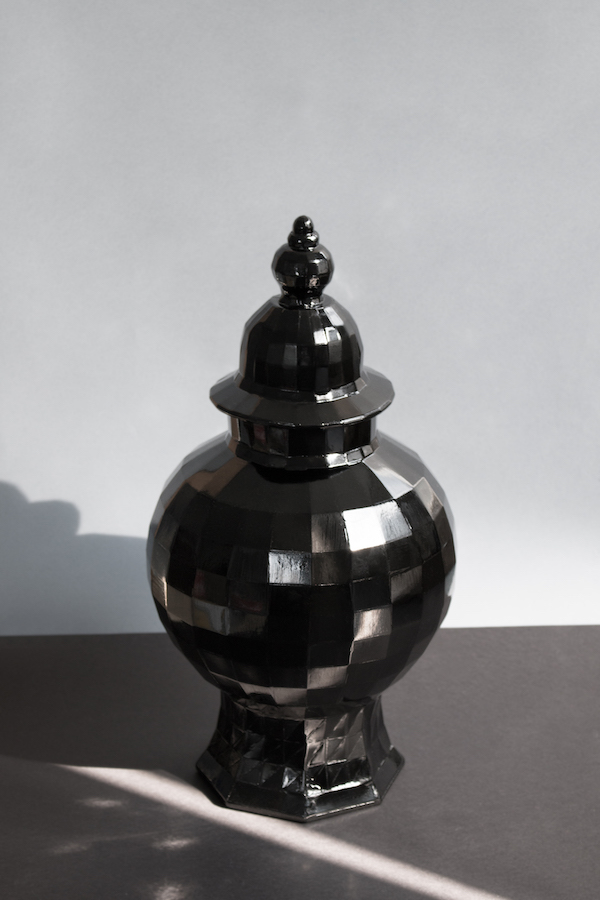
Panta Rhei
Cherry, Marble, Brass, Soap
250(H) x 370(W) x 170(D)
Cherry, Marble, Brass, Soap
250(H) x 370(W) x 170(D)
When I traveled to Iceland, I was constantly confronted with the contours of mountains wherever I went. The mountains were not merely the background of the landscape, but its entirety; vast silhouettes stretching across the horizon, meeting the expansive earth, offering an experience that was overwhelming in itself. As I gazed at these mountains for a long time, I realized that they were not simply scenery but “sculptures of time,” shaped and weathered over millions of years by wind, rain, ice, and volcanic activity. The form of the mountain was not just a geographical structure, but a sculptural record that condensed geological time and the flow of climate.
In that moment, I began to reflect on the concept of “time” in a new way. We usually measure and perceive time through the hands of a clock or the changing dates on a calendar. Yet time does not exist only as numbers and units—it can also be sensed through the transformation of form and the decay of matter. A rusting iron structure, a candle melting away, paper aging and fabric fading: all of these are traces left by the passage of time, and each is a face of time revealed through changing material. As forms shift and substances alter, we experience abstract time in tangible ways.
This way of thinking extended into the realm of my everyday objects. I discovered that the bar of soap I use daily in my bathroom was also a vessel of time. Each time I wash my hands or take a shower, the soap changes form: its edges are worn away, its surface grows smoother, and it transforms into irregular curves. These changes can be seen with the eyes and felt directly with the fingers. Soap thus becomes more than a functional cleansing tool—it becomes an object through which we recognize the flow of time in our daily actions. The marks it leaves and its diminishing volume make the passage of time visible and experiential, in a way that is anything but abstract.
To translate this realization into my work, I chose as my material the standardized, mass-produced bars of soap from the factory. As industrial products, soaps are designed for efficiency and uniformity, bound by regularized shapes. Yet I used a microwave as a tool to allow the soap to return to its natural materiality. Exposed to heat, the soap began to sag and warp, the machine-made straight lines and flat planes dissolving into organic, irregular curves. The transformation resembled the mountains of Iceland themselves—forms sculpted and reshaped over millions of years by erosion and weathering. The soap’s process of revealing its own inherent materiality became an allegory of human-made standardization rendered powerless in the face of natural flows of time.
Alongside this transformed soap, I designed a complementary stand. The stand was not meant merely to hold the soap in a practical sense, but to serve as a stage through which the object could be experienced as a sculptural presence. Together, the soap and its stand created a small landscape, a microcosm where time manifested in subtle yet perceptible ways. Through the ordinary act of washing, the viewer could witness the gradual change of the soap, and in doing so, contemplate the passage of time itself.
In this work, the soap holds two identities at once. On one hand, it retains its original function as a utilitarian object for cleansing. On the other hand, it becomes a material that, through transformation and eventual disappearance, offers a meditative experience. The daily erosion of the soap reveals both vanishing and becoming, allowing us to rediscover the essence of time within the fabric of ordinary life.
Ultimately, this soap object serves as a bridge between the everyday and the artistic, between functionality and meditation. The standardized product of mass production is guided back to its organic material nature, showing us the point where human systems collide with, and reconcile with, the order of nature. It becomes a device through which the abstract concept of time is experienced in the most mundane of daily actions. With this project, I sought to suggest that even the most ordinary objects we use every day can become philosophical artifacts that embody the flow of time.
This soap and its stand are no longer mere household tools; they are small sculptural works in which time, form, material, and concept intersect. Through them, viewers and users are invited to notice once more the time embedded in everyday touch and the traces of change inscribed within matter. They remind us that time is not merely numbers or units, but a “living experience” that is constantly felt through objects and actions.
-
아이슬란드를 여행했을 때, 나는 어디에 있든지 늘 눈앞에 펼쳐진 산의 윤곽선을 바라볼 수 있었다. 산은 그곳 풍경의 배경이자 전부였고, 광활한 대지와 맞닿은 거대한 실루엣은 그 자체로 압도적인 경험이었다. 한참 동안 산을 바라보던 나는 그것이 단순한 풍경이 아니라, 수백만 년 동안 바람과 비, 얼음과 화산 활동이 겹겹이 흔적을 남기며 다듬어 온 ‘시간의 조형물’이라는 사실을 깨닫게 되었다. 자연이 빚어낸 산의 형상은 단순한 지리적 구조물이 아니라, 지질학적 시간과 기후의 흐름을 응축한 조형적 기록이었다.
그 순간 나는 ‘시간’이라는 개념을 새롭게 사유하기 시작했다. 우리는 흔히 시계의 바늘이나 달력의 날짜를 통해 시간을 측정하고 인식한다. 그러나 시간은 숫자나 단위로만 존재하는 것이 아니라, 형태의 변화와 물질의 소멸을 통해서도 감각된다. 녹슬어 가는 철제 구조물, 서서히 녹아내리는 촛불, 낡아가는 종이와 바래지는 천. 이 모든 것은 시간의 흐름이 남긴 흔적이자, 변화하는 물질을 통해 우리에게 감각적으로 전달되는 ‘시간의 얼굴’이다. 형태가 바뀌고 물성이 달라지는 과정 속에서 우리는 추상적인 시간을 구체적인 감각으로 경험한다.
이러한 사유는 내 일상의 사물로까지 확장되었다. 나는 매일 사용하는 욕실의 비누 또한 시간의 흐름을 보여주는 사물이라는 것을 발견했다. 손을 씻거나 샤워를 할 때마다 비누는 조금씩 깎이고, 모서리는 사라지며, 매끄럽고 불규칙한 곡선으로 바뀌어 간다. 비누의 변화는 눈으로 확인할 수 있고 손끝으로 직접 느낄 수 있다. 즉, 비누는 단순히 세정의 기능을 넘어서, 일상의 동작 속에서 시간의 흐름을 인식하게 하는 사물이 되는 것이다. 비누가 남긴 자국과 줄어든 크기는 ‘흘러가는 시간’을 추상적이지 않은 방식으로 우리 앞에 드러낸다.
나는 이 발견을 작업으로 구체화하기 위해, 공장에서 대량 생산된 표준화된 형태의 비누를 재료로 삼았다. 공산품으로서의 비누는 효율성과 균일성을 위해 규격화된 형태를 가진다. 그러나 나는 전자레인지라는 도구를 사용해 비누가 본래의 물성을 되찾도록 유도했다. 열에 의해 비누는 서서히 흐트러지고 휘어지며, 공장에서 찍어낸 매끈한 직선과 평면은 사라지고 유기적이고 불규칙한 곡선으로 변화했다. 이는 마치 자연 속에서 수백만 년 동안 침식과 풍화 작용을 거쳐 형상을 바꾼 산과도 닮아 있었다. 비누가 스스로의 물성을 드러내며 형상 변화를 겪는 과정은, 인간이 만든 규격적 형식이 자연스러운 시간의 흐름 앞에서 무력해지는 순간을 은유적으로 보여준다.
나는 이렇게 변화한 특별한 비누 오브제에 어울리는 받침대를 함께 디자인했다. 받침대는 단순히 비누를 받치는 실용적 기능을 넘어서, 오브제를 하나의 조형적 장치로 경험하게 하는 무대가 된다. 비누와 받침대가 어우러지며 하나의 작은 풍경을 이루고, 그 안에서 시간은 미묘하고도 감각적인 방식으로 드러난다. 관람자는 매일의 세정 행위를 통해 비누가 변화하는 과정을 직접 목격하며, 그 변화를 통해 시간의 흐름을 사유하게 된다.
이 작업에서 비누는 두 가지 성격을 동시에 가진다. 하나는 여전히 본래의 기능을 수행하는 생활용품이라는 점이다. 손을 씻고 몸을 씻는 과정에서 비누는 실용적인 쓰임을 잃지 않는다. 그러나 다른 한편에서, 비누는 시간이 흐르며 형태를 바꾸고 결국 사라져 가는 물질로서, 우리에게 명상적인 경험을 제공한다. 매일 조금씩 깎여 나가는 비누의 변화는 사라짐과 생성을 동시에 드러내며, 일상 속에서 시간의 본질을 다시금 깨닫게 만든다.
결국 이 비누 오브제는 일상과 예술, 실용과 명상을 잇는 다리와 같다. 규격화된 공산품이 자연스러운 물성으로 되돌아가는 과정은, 인간이 만든 시스템과 자연의 질서가 충돌하고 조화를 이루는 지점을 보여준다. 또한 그것은 시간이라는 추상적 개념을 가장 사소한 일상 속에서 감각적으로 체험하게 하는 장치가 된다. 나는 이 프로젝트를 통해, 우리가 매일 사용하는 가장 평범한 사물조차 시간의 흐름을 담은 철학적 오브제가 될 수 있음을 제시하고 싶었다.
이 비누와 받침대는 단순한 생활 도구가 아니라, 시간과 형태, 물질과 개념이 교차하는 작은 조각품이다. 관람자와 사용자는 이를 통해 손끝에서 느껴지는 일상의 시간, 그리고 사물 속에 새겨진 변화의 흔적을 다시금 주목하게 된다. 그것은 우리에게 시간이란 단지 숫자나 단위가 아니라, 사물과 행위를 통해 끊임없이 감각되는 ‘살아 있는 경험’임을 일깨운다.
* Nominated Melkweg Award 2016
In that moment, I began to reflect on the concept of “time” in a new way. We usually measure and perceive time through the hands of a clock or the changing dates on a calendar. Yet time does not exist only as numbers and units—it can also be sensed through the transformation of form and the decay of matter. A rusting iron structure, a candle melting away, paper aging and fabric fading: all of these are traces left by the passage of time, and each is a face of time revealed through changing material. As forms shift and substances alter, we experience abstract time in tangible ways.
This way of thinking extended into the realm of my everyday objects. I discovered that the bar of soap I use daily in my bathroom was also a vessel of time. Each time I wash my hands or take a shower, the soap changes form: its edges are worn away, its surface grows smoother, and it transforms into irregular curves. These changes can be seen with the eyes and felt directly with the fingers. Soap thus becomes more than a functional cleansing tool—it becomes an object through which we recognize the flow of time in our daily actions. The marks it leaves and its diminishing volume make the passage of time visible and experiential, in a way that is anything but abstract.
To translate this realization into my work, I chose as my material the standardized, mass-produced bars of soap from the factory. As industrial products, soaps are designed for efficiency and uniformity, bound by regularized shapes. Yet I used a microwave as a tool to allow the soap to return to its natural materiality. Exposed to heat, the soap began to sag and warp, the machine-made straight lines and flat planes dissolving into organic, irregular curves. The transformation resembled the mountains of Iceland themselves—forms sculpted and reshaped over millions of years by erosion and weathering. The soap’s process of revealing its own inherent materiality became an allegory of human-made standardization rendered powerless in the face of natural flows of time.
Alongside this transformed soap, I designed a complementary stand. The stand was not meant merely to hold the soap in a practical sense, but to serve as a stage through which the object could be experienced as a sculptural presence. Together, the soap and its stand created a small landscape, a microcosm where time manifested in subtle yet perceptible ways. Through the ordinary act of washing, the viewer could witness the gradual change of the soap, and in doing so, contemplate the passage of time itself.
In this work, the soap holds two identities at once. On one hand, it retains its original function as a utilitarian object for cleansing. On the other hand, it becomes a material that, through transformation and eventual disappearance, offers a meditative experience. The daily erosion of the soap reveals both vanishing and becoming, allowing us to rediscover the essence of time within the fabric of ordinary life.
Ultimately, this soap object serves as a bridge between the everyday and the artistic, between functionality and meditation. The standardized product of mass production is guided back to its organic material nature, showing us the point where human systems collide with, and reconcile with, the order of nature. It becomes a device through which the abstract concept of time is experienced in the most mundane of daily actions. With this project, I sought to suggest that even the most ordinary objects we use every day can become philosophical artifacts that embody the flow of time.
This soap and its stand are no longer mere household tools; they are small sculptural works in which time, form, material, and concept intersect. Through them, viewers and users are invited to notice once more the time embedded in everyday touch and the traces of change inscribed within matter. They remind us that time is not merely numbers or units, but a “living experience” that is constantly felt through objects and actions.
-
아이슬란드를 여행했을 때, 나는 어디에 있든지 늘 눈앞에 펼쳐진 산의 윤곽선을 바라볼 수 있었다. 산은 그곳 풍경의 배경이자 전부였고, 광활한 대지와 맞닿은 거대한 실루엣은 그 자체로 압도적인 경험이었다. 한참 동안 산을 바라보던 나는 그것이 단순한 풍경이 아니라, 수백만 년 동안 바람과 비, 얼음과 화산 활동이 겹겹이 흔적을 남기며 다듬어 온 ‘시간의 조형물’이라는 사실을 깨닫게 되었다. 자연이 빚어낸 산의 형상은 단순한 지리적 구조물이 아니라, 지질학적 시간과 기후의 흐름을 응축한 조형적 기록이었다.
그 순간 나는 ‘시간’이라는 개념을 새롭게 사유하기 시작했다. 우리는 흔히 시계의 바늘이나 달력의 날짜를 통해 시간을 측정하고 인식한다. 그러나 시간은 숫자나 단위로만 존재하는 것이 아니라, 형태의 변화와 물질의 소멸을 통해서도 감각된다. 녹슬어 가는 철제 구조물, 서서히 녹아내리는 촛불, 낡아가는 종이와 바래지는 천. 이 모든 것은 시간의 흐름이 남긴 흔적이자, 변화하는 물질을 통해 우리에게 감각적으로 전달되는 ‘시간의 얼굴’이다. 형태가 바뀌고 물성이 달라지는 과정 속에서 우리는 추상적인 시간을 구체적인 감각으로 경험한다.
이러한 사유는 내 일상의 사물로까지 확장되었다. 나는 매일 사용하는 욕실의 비누 또한 시간의 흐름을 보여주는 사물이라는 것을 발견했다. 손을 씻거나 샤워를 할 때마다 비누는 조금씩 깎이고, 모서리는 사라지며, 매끄럽고 불규칙한 곡선으로 바뀌어 간다. 비누의 변화는 눈으로 확인할 수 있고 손끝으로 직접 느낄 수 있다. 즉, 비누는 단순히 세정의 기능을 넘어서, 일상의 동작 속에서 시간의 흐름을 인식하게 하는 사물이 되는 것이다. 비누가 남긴 자국과 줄어든 크기는 ‘흘러가는 시간’을 추상적이지 않은 방식으로 우리 앞에 드러낸다.
나는 이 발견을 작업으로 구체화하기 위해, 공장에서 대량 생산된 표준화된 형태의 비누를 재료로 삼았다. 공산품으로서의 비누는 효율성과 균일성을 위해 규격화된 형태를 가진다. 그러나 나는 전자레인지라는 도구를 사용해 비누가 본래의 물성을 되찾도록 유도했다. 열에 의해 비누는 서서히 흐트러지고 휘어지며, 공장에서 찍어낸 매끈한 직선과 평면은 사라지고 유기적이고 불규칙한 곡선으로 변화했다. 이는 마치 자연 속에서 수백만 년 동안 침식과 풍화 작용을 거쳐 형상을 바꾼 산과도 닮아 있었다. 비누가 스스로의 물성을 드러내며 형상 변화를 겪는 과정은, 인간이 만든 규격적 형식이 자연스러운 시간의 흐름 앞에서 무력해지는 순간을 은유적으로 보여준다.
나는 이렇게 변화한 특별한 비누 오브제에 어울리는 받침대를 함께 디자인했다. 받침대는 단순히 비누를 받치는 실용적 기능을 넘어서, 오브제를 하나의 조형적 장치로 경험하게 하는 무대가 된다. 비누와 받침대가 어우러지며 하나의 작은 풍경을 이루고, 그 안에서 시간은 미묘하고도 감각적인 방식으로 드러난다. 관람자는 매일의 세정 행위를 통해 비누가 변화하는 과정을 직접 목격하며, 그 변화를 통해 시간의 흐름을 사유하게 된다.
이 작업에서 비누는 두 가지 성격을 동시에 가진다. 하나는 여전히 본래의 기능을 수행하는 생활용품이라는 점이다. 손을 씻고 몸을 씻는 과정에서 비누는 실용적인 쓰임을 잃지 않는다. 그러나 다른 한편에서, 비누는 시간이 흐르며 형태를 바꾸고 결국 사라져 가는 물질로서, 우리에게 명상적인 경험을 제공한다. 매일 조금씩 깎여 나가는 비누의 변화는 사라짐과 생성을 동시에 드러내며, 일상 속에서 시간의 본질을 다시금 깨닫게 만든다.
결국 이 비누 오브제는 일상과 예술, 실용과 명상을 잇는 다리와 같다. 규격화된 공산품이 자연스러운 물성으로 되돌아가는 과정은, 인간이 만든 시스템과 자연의 질서가 충돌하고 조화를 이루는 지점을 보여준다. 또한 그것은 시간이라는 추상적 개념을 가장 사소한 일상 속에서 감각적으로 체험하게 하는 장치가 된다. 나는 이 프로젝트를 통해, 우리가 매일 사용하는 가장 평범한 사물조차 시간의 흐름을 담은 철학적 오브제가 될 수 있음을 제시하고 싶었다.
이 비누와 받침대는 단순한 생활 도구가 아니라, 시간과 형태, 물질과 개념이 교차하는 작은 조각품이다. 관람자와 사용자는 이를 통해 손끝에서 느껴지는 일상의 시간, 그리고 사물 속에 새겨진 변화의 흔적을 다시금 주목하게 된다. 그것은 우리에게 시간이란 단지 숫자나 단위가 아니라, 사물과 행위를 통해 끊임없이 감각되는 ‘살아 있는 경험’임을 일깨운다.
* Nominated Melkweg Award 2016

